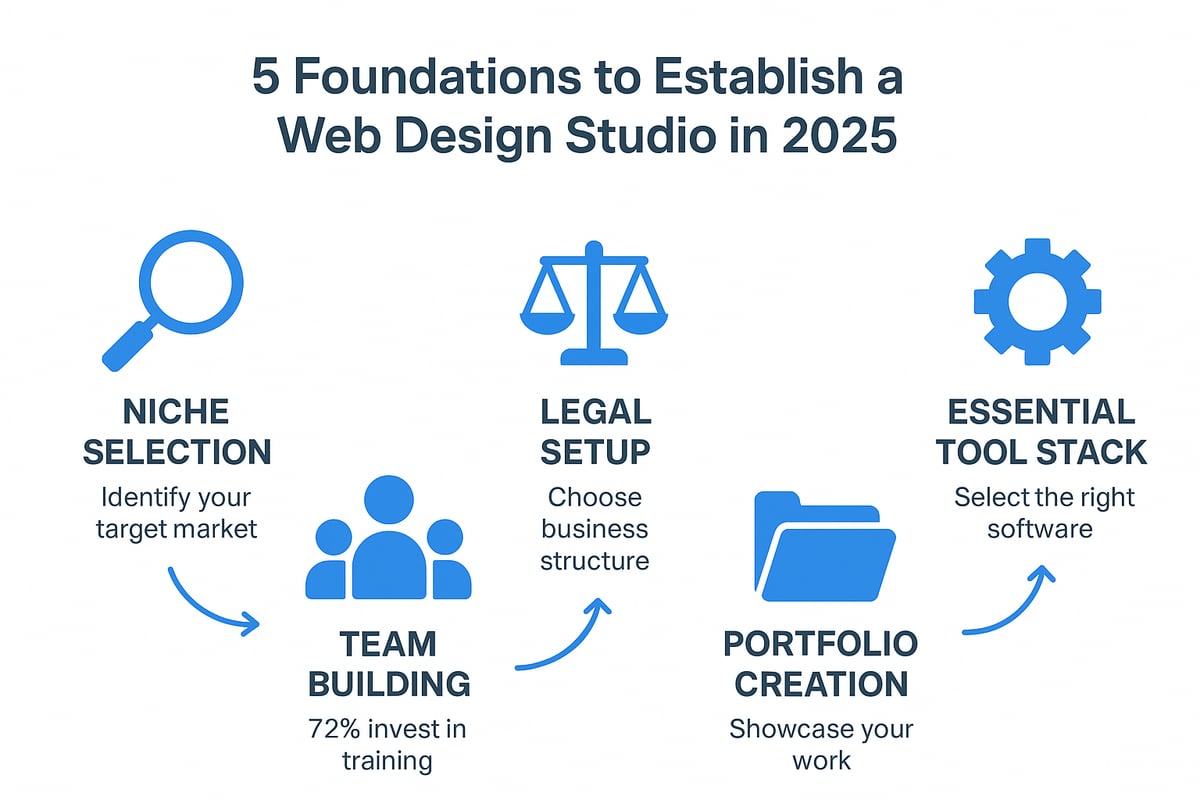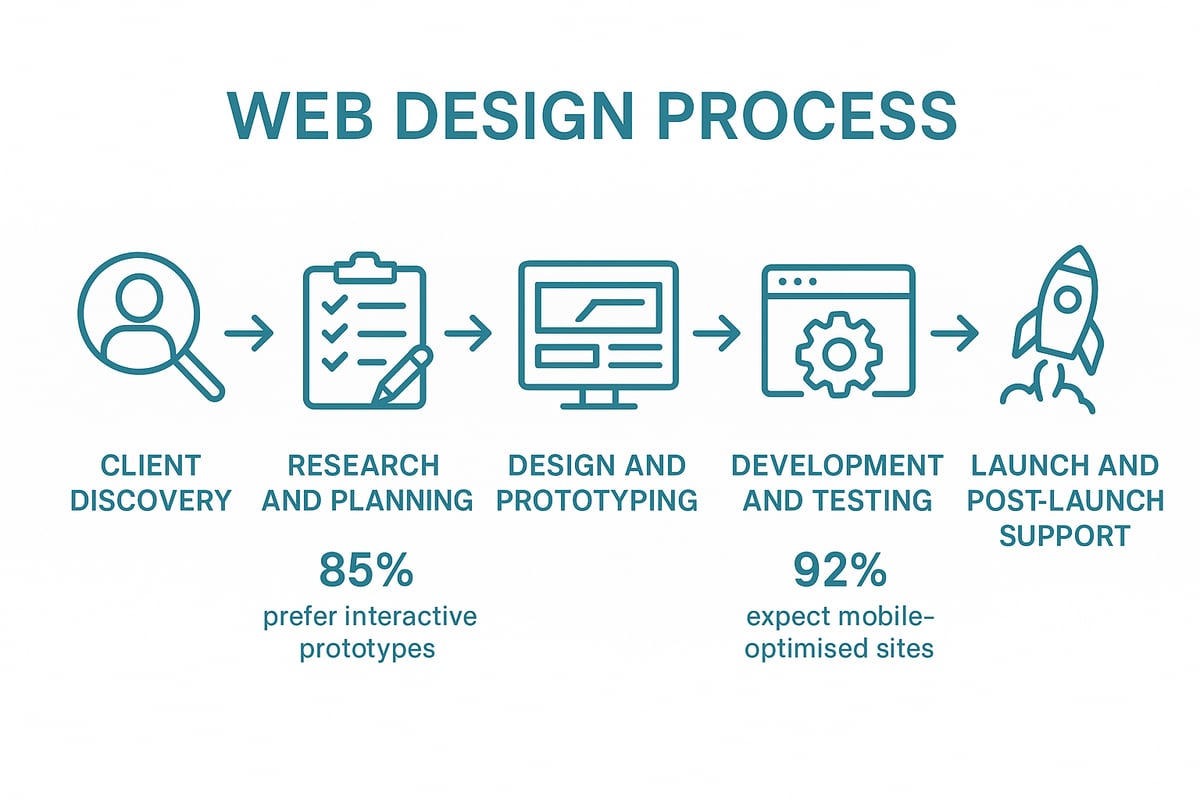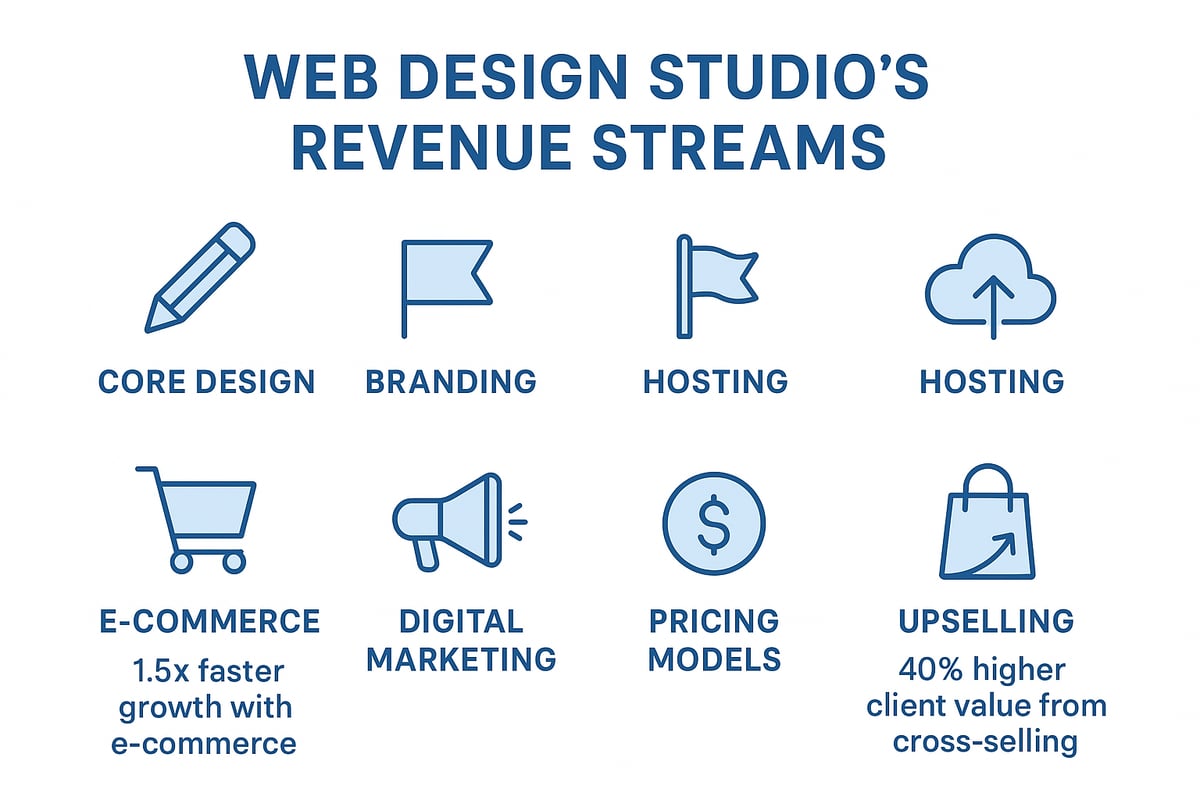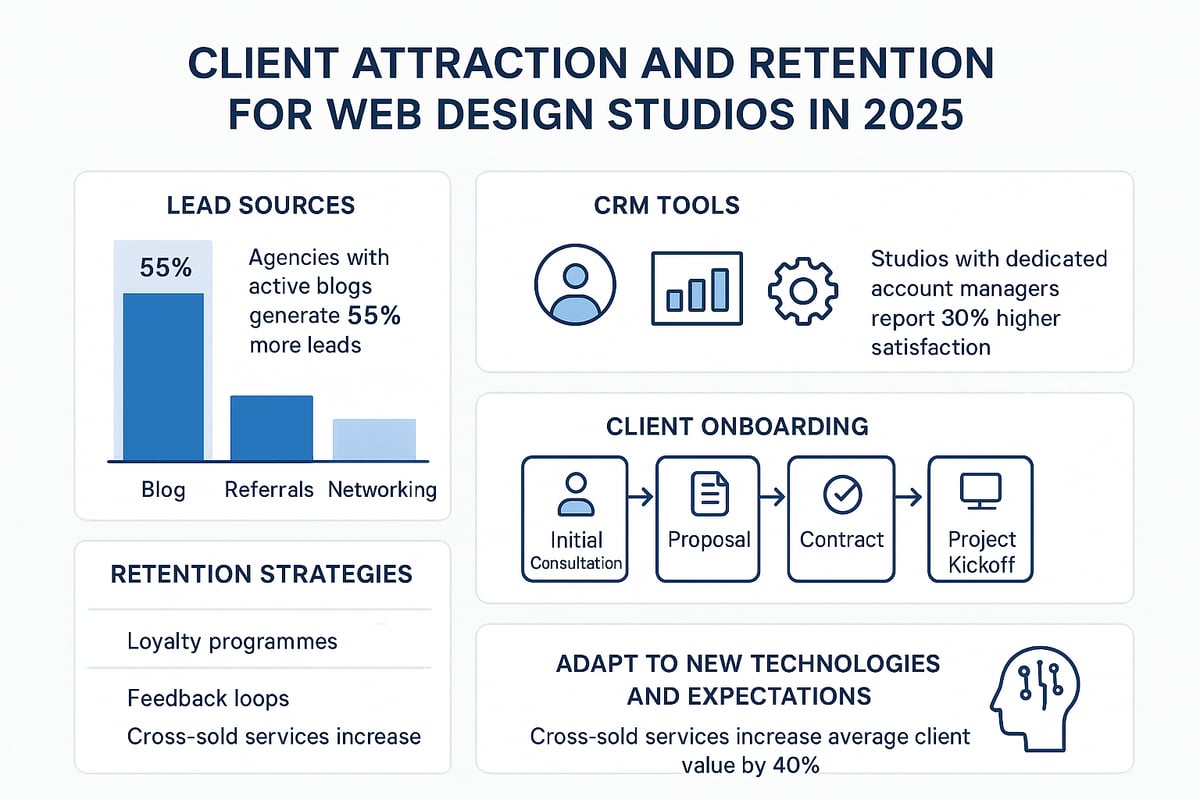In 2025, the digital landscape continues to evolve at a rapid pace. To succeed, your web design studio must capture attention and stand out from the crowd.
This essential handbook delivers a step-by-step, expert-driven guide to building, managing, and scaling a web design studio in today’s competitive market. You will discover practical strategies to establish your studio, master the latest tools, streamline workflows, attract clients, and future-proof your business.
Explore actionable insights tailored to help you thrive. Ready to elevate your web design studio and achieve measurable results? Let’s get started.
Establishing Your Web Design Studio in 2025
Setting up a web design studio in 2025 is an exciting yet challenging journey. Success requires careful planning, strategic decisions, and a deep understanding of the digital landscape. The following steps break down the essential foundations needed to launch and grow a competitive web design studio.

Defining Your Niche and Value Proposition
Specialisation is crucial for a web design studio aiming to stand out in a crowded market. By focusing on a specific niche, such as e-commerce, SaaS, or eco-friendly brands, you position your studio as an expert, attracting higher-value clients.
Start by researching market demand and identifying profitable sectors. Consider where your team's expertise aligns with emerging trends. Craft a unique selling proposition that clearly communicates what makes your web design studio different. For example, studios specialising in eco-conscious brands often achieve 20% higher client retention due to shared values and tailored solutions.
A strong value proposition will help your web design studio attract the right clients from the outset, laying a solid foundation for growth.
Legal, Financial, and Operational Setup
Establishing a web design studio in the UK requires careful attention to legal, financial, and operational details. Choosing the right legal structure is essential—options include sole trader, partnership, or limited company.
Set up a dedicated business banking account and implement robust accounting systems for transparency. Secure appropriate business insurance to protect against unforeseen challenges. Always use clear contracts with clients, which can reduce disputes by up to 35%.
Here is a quick comparison:
| Legal Structure | Pros | Cons |
|---|---|---|
| Sole Trader | Simple, low cost | Personal liability |
| Partnership | Shared responsibility | Joint liability |
| Limited Company | Limited liability | More admin required |
Managing these aspects efficiently ensures your web design studio operates smoothly and remains compliant with regulations.
Building a Skilled Team
A high-performing web design studio relies on a blend of creative and technical talent. Key roles include designers, developers, project managers, and quality assurance specialists.
Decide whether to hire in-house staff, work with freelancers, or partner with agencies. Each approach offers different advantages in terms of flexibility and expertise. Invest in upskilling your team, focusing on certifications and tools relevant for 2025.
Recent data shows that 72% of successful studios commit to ongoing staff training. This investment keeps your web design studio ahead of the curve and ready to tackle evolving client needs.
Crafting a Portfolio and Website
Your portfolio is the shop window for your web design studio. Showcase diverse, high-quality projects, and include detailed case studies and testimonials to build trust. Interactive portfolios are especially effective, with studios reporting up to 40% more enquiries as a result.
Incorporate SEO and UX best practices on your website to increase visibility and engagement. For inspiration and examples of compelling portfolios, explore Creating a strong online portfolio.
A well-crafted portfolio demonstrates your web design studio's capabilities and makes a lasting impression on prospective clients.
Essential Tools and Software Stack
The right tools empower your web design studio to deliver projects efficiently and at the highest standard. For design, industry leaders include Figma, Adobe XD, and Sketch. Developers benefit from using VS Code, GitHub, and Webflow.
Project management tools such as Asana, Trello, and Slack streamline communication and workflow. Integrate automation solutions and time tracking to maximise productivity.
Staying current with your software stack ensures your web design studio remains agile and competitive as technologies evolve.
Mastering the Web Design Process: From Brief to Launch
Navigating the entire project lifecycle is crucial for any web design studio aiming to deliver consistent, high-quality results. A well-structured process ensures clear communication, efficient workflows, and satisfied clients. Let us explore each stage, from initial brief to successful site launch, and see how a web design studio can set itself apart in 2025.

Client Discovery and Onboarding
The journey for any web design studio begins with understanding the client’s needs. Effective discovery starts with in-depth interviews, where you gather requirements, project goals, and key pain points. By asking the right questions, your team can identify must-have features, preferred design styles, and business objectives.
Clear expectations are vital. Define deliverables, timelines, and communication channels upfront. Many studios now run discovery workshops, involving stakeholders early to align vision and strategy. This approach not only builds trust but also reduces costly misunderstandings later.
A web design studio that excels in onboarding will foster long-term relationships and set the stage for project success.
Research, Planning, and Strategy
With client insights in hand, the next step for a web design studio is thorough research and planning. Begin with a competitor analysis to benchmark features, design trends, and user experience standards. Audience analysis helps clarify user demographics, behaviours, and motivations.
Build detailed user personas and map out customer journeys. This ensures your solutions are user-centric and tailored to real needs. Wireframes and sitemaps then bring structure to the project, allowing both your team and the client to visualise site architecture and navigation.
By investing in solid planning, a web design studio can avoid scope creep and deliver value-driven results.
Design and Prototyping
The design phase is where creativity and strategy blend. In 2025, a web design studio must embrace UI/UX best practices such as dark mode, accessibility, and engaging micro-interactions. Collaborative prototyping tools enable real-time feedback, making the design process interactive and transparent.
Clients increasingly prefer interactive prototypes over static mockups, with 85% expressing this preference. Staying ahead of web design trends for 2025 ensures your studio delivers modern, future-ready solutions.
A web design studio that prioritises inclusive and trend-driven design will stand out and appeal to a broader audience.
Development and Testing
Transitioning to development, a web design studio selects the right tech stack for each project. Options include WordPress, Jamstack, or headless CMS, depending on client needs. Responsive and mobile-first principles are non-negotiable, as 92% of users expect seamless mobile experiences.
Rigorous cross-browser and device testing is essential to identify issues before launch. Use automated tools and manual checks to ensure quality across platforms. Integrating feedback loops between developers and designers keeps the project on track.
By focusing on robust development and testing, a web design studio ensures reliability and client satisfaction.
Launch and Post-Launch Support
The final stage is launching the site and providing ongoing support. A detailed pre-launch checklist covers final QA, SEO setup, and analytics integration. These steps help your web design studio deliver a polished and discoverable website.
After launch, offer maintenance, updates, and client training. Proactive post-launch support leads to higher client retention and positions your studio as a trusted digital partner.
By mastering each stage from brief to launch, a web design studio can consistently deliver outstanding results and foster long-term growth.
Essential Services and Revenue Streams for Studios
A thriving web design studio in 2025 must offer a diverse range of services while ensuring each stream aligns with client needs and market trends. Building a robust portfolio of offerings is essential for attracting clients, increasing revenue, and ensuring long-term sustainability. Let us explore the critical services and strategies that drive growth for modern studios.

Core Offerings: Design, Development, and Branding
Every successful web design studio builds its foundation on exceptional design, reliable development, and impactful branding. These core services include custom website design, site redesigns, and the creation of brand identities that set clients apart. Studios also provide UX and UI consulting, ensuring that every site is intuitive and visually appealing.
- Custom website design and redesign
- Brand identity and logo creation
- UX/UI audits and consulting
Delivering these essential services establishes credibility and differentiates a web design studio from competitors. By showcasing expertise in these areas, studios attract a wide range of clients seeking both creative and technical solutions.
Expanding with SEO, Hosting, and Maintenance
To remain competitive, a web design studio must extend its services beyond design and development. SEO packages, including local, technical, and ongoing optimisation, are now standard expectations for clients. Offering web hosting—whether managed or cloud-based—ensures sites are secure and fast, while maintenance plans cover updates, security, and technical support.
For actionable ways to boost site visibility, review these Essential SEO tips for start-ups. Integrating these services provides clients with a seamless experience and helps studios build recurring revenue streams, fostering long-term relationships.
Diversifying with E-commerce and Digital Marketing
Diversification is crucial for a web design studio aiming to grow in a dynamic market. E-commerce site development—using platforms like WooCommerce or Shopify—caters to the increasing demand for online sales solutions. Studios also expand into digital marketing, offering services such as pay-per-click advertising, content creation, and social media management.
- E-commerce development (WooCommerce, Shopify)
- PPC and content marketing
- Social media campaigns
Studios that offer e-commerce solutions report 1.5x faster growth, positioning themselves as one-stop shops for clients venturing into digital sales.
Packaging and Pricing Strategies
A strategic approach to packaging and pricing is vital for a web design studio to scale. Studios often choose between fixed-price, retainer-based, or value-driven pricing models. Transparent proposals and clear contracts build trust and reduce misunderstandings.
| Pricing Model | Description | Ideal For |
|---|---|---|
| Fixed-Price | Set cost per project | Short-term projects |
| Retainer | Ongoing monthly fee | Long-term partnerships |
| Value-Based | Price based on client value delivered | High-impact projects |
Studios offering tiered packages close 25% more deals, providing options that suit different budgets and project scopes.
Upselling and Cross-selling Techniques
Maximising client value is a hallmark of a high-performing web design studio. By identifying additional client needs, studios can upsell complementary services such as SEO, ongoing maintenance, or digital marketing. Cross-selling creates long-term relationships and increases average client value by up to 40 percent.
- Regular reviews to identify new opportunities
- Bundling services for convenience
- Implementing loyalty and referral programmes
This proactive approach not only boosts revenue but also strengthens client loyalty and retention, ensuring sustainable growth for the studio.
Attracting and Retaining Clients in a Crowded Market
Standing out in today’s crowded web design studio landscape demands more than just technical skill. The industry is evolving rapidly, with new trends and client expectations shaping how studios attract and retain business. According to the Web Design Industry Growth Trends, competition will only intensify in 2025, making it crucial to build a memorable brand and deliver genuine value.

Building a Powerful Brand and Online Presence
A successful web design studio must invest in a distinctive brand identity and consistent messaging. Start by defining your studio’s values and visual language, ensuring your website, social channels, and portfolios reflect your expertise.
Content marketing is a proven way to build authority. Agencies with active blogs generate 55% more leads, as clients trust studios that share insights and thought leadership. Showcase your work with case studies and testimonials, and optimise your site for search engines.
The web design studio brand is your promise; back it up with real results and a clear value proposition. Position your studio as a go-to expert in your chosen niche.
Networking and Partnerships
Growing your web design studio requires building strong industry connections. Networking opens doors to referrals, collaborations, and new client segments.
- Join professional associations and local business groups.
- Attend industry events, conferences, and workshops.
- Collaborate with complementary providers, such as digital marketers or copywriters.
Partnerships can help your web design studio access larger projects and tap into shared resources. Regularly engage with your network and nurture relationships to foster long-term business growth.
Effective Sales and Lead Generation Tactics
To keep your web design studio pipeline full, use a blend of inbound and outbound marketing. Inbound tactics include publishing helpful resources, hosting webinars, and sharing client success stories. Outbound methods involve direct outreach, targeted emails, and personalised proposals.
Social proof is essential. Reviews, testimonials, and case studies build trust, with 63% of clients choosing studios based on reputation. For more insights on how digital marketing is shaping sales strategies, see the State of Digital Marketing Web Design.
A proactive approach to sales ensures your web design studio is top-of-mind when clients are ready to invest.
Managing Client Relationships and Communication
Clear communication is the backbone of any thriving web design studio. Set expectations from the start, provide regular updates, and be transparent about timelines and deliverables.
Use CRM tools to track leads, monitor project progress, and manage client data efficiently. Studios with dedicated account managers report 30% higher satisfaction, as clients appreciate having a single point of contact.
Prompt responses and a professional approach reinforce trust, encouraging repeat business and positive referrals.
Retention and Referral Strategies
Long-term success for a web design studio depends on retaining clients and generating referrals. Implement loyalty programmes, such as discounts for repeat projects or priority support, to reward ongoing partnerships.
| Retention Tactic | Benefit |
|---|---|
| Loyalty discounts | Encourages repeat business |
| Feedback surveys | Improves client experience |
| Referral incentives | Attracts new clients |
| Regular check-ins | Builds lasting relationships |
Gather feedback, act on suggestions, and celebrate client wins. A structured referral programme can turn satisfied clients into your best advocates.
Adapting to Changing Client Expectations in 2025
Client needs are evolving. In 2025, flexibility and personalisation are key. Offer multiple communication channels, from video calls to instant chat, to suit diverse preferences.
Stay ahead by customising solutions for different industries, and monitor emerging trends and technologies to keep your web design studio future-ready. According to the State of Digital Marketing Web Design, embracing mobile-first design and AI tools is no longer optional.
By continually refining your service and staying client-focused, your web design studio can thrive in an ever-changing market.
Future-Proofing Your Web Design Studio
Staying ahead in the digital sector requires your web design studio to anticipate change, embrace innovation, and build resilience. Future-proofing is not just about adopting the latest trends, but about creating a sustainable, adaptable business ready to thrive in 2025 and beyond.
Embracing New Technologies and Trends
To ensure your web design studio remains competitive, embracing emerging technologies is vital. Artificial intelligence, automation, and conversational interfaces are rapidly transforming the sector. AI-powered design tools now streamline everything from prototyping to content generation, letting teams work smarter and faster.
Consider integrating voice search optimisation and micro-interactions into your service offering. According to recent data, 40 percent of websites will feature AI design elements by 2025. In fact, AI Integration in Web Design highlights that 93 percent of designers will use AI in their workflows. Adopting these technologies positions your web design studio as a leader, delivering modern solutions that clients expect.
Sustainability and Accessibility as Differentiators
Modern clients value environmental responsibility and inclusivity. Your web design studio can stand out by implementing eco-friendly practices, such as using green hosting providers and optimising site assets for minimal energy consumption.
Accessibility is equally important. Meeting WCAG 2.2 standards is a must, ensuring your sites are usable for all, including people with disabilities. Accessible sites reach a 20 percent wider audience, which can boost your studio’s reputation and client base. Prioritising sustainability and accessibility demonstrates your commitment to ethical, future-ready web design.
Scaling Your Studio: Growth Strategies
Scaling a web design studio demands a strategic approach. Start by expanding your service offerings to cater to new markets, such as mobile apps or e-commerce. Developing remote and hybrid teams can help you access top talent and reduce overheads by up to 25 percent.
Growth also means refining internal processes. Implement project management tools and automate repetitive tasks where possible. Explore partnerships with complementary agencies to broaden your reach. These steps will help your web design studio grow sustainably and efficiently.
Continuous Learning and Professional Development
Keeping your team’s skills sharp is essential for long-term success. Encourage participation in webinars, online courses, and industry events. Allocate annual training budgets, as agencies investing in professional development outperform peers by 18 percent.
Certifications in emerging technologies add credibility to your web design studio. Foster a culture of lifelong learning, where designers, developers, and managers share knowledge and stay updated on industry shifts. This ongoing investment will keep your studio at the forefront of innovation.
Measuring Success and Refining Processes
Measuring progress is critical for any web design studio aiming to future-proof its operations. Set clear key performance indicators (KPIs), such as client retention, project delivery times, and lead conversion rates. Use analytics tools to monitor website performance and client engagement.
Implement regular feedback loops, both internally and with clients. Assess what works and what needs improvement. By continually refining your processes, your web design studio will adapt more quickly to changes and maintain high standards of service.
Navigating Challenges and Risks
Every web design studio faces challenges, from economic uncertainty to evolving regulations. Managing cash flow effectively is crucial for stability. Protect your studio against cyber threats by keeping software updated and educating your team on security best practices.
Stay informed about data privacy laws like GDPR, and ensure compliance in all projects. Anticipating risks and having contingency plans in place will help your web design studio remain resilient, no matter what the future brings.
